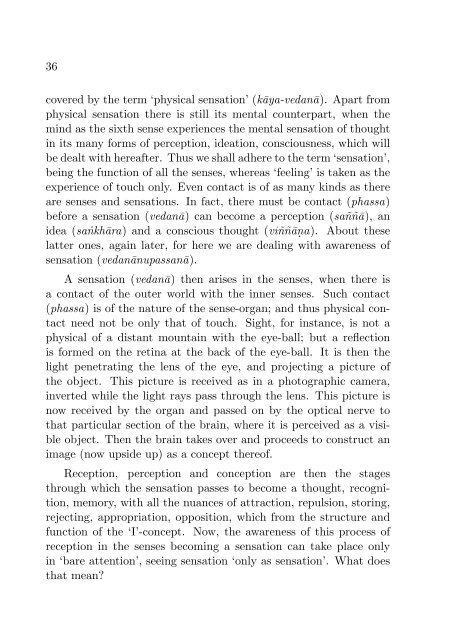Awareness in Buddhist Meditation
A detailed description of awareness in Buddhist Meditation.
A detailed description of awareness in Buddhist Meditation.
You also want an ePaper? Increase the reach of your titles
YUMPU automatically turns print PDFs into web optimized ePapers that Google loves.
36<br />
covered by the term ‘physical sensation’ (kāya-vedanā). Apart from<br />
physical sensation there is still its mental counterpart, when the<br />
m<strong>in</strong>d as the sixth sense experiences the mental sensation of thought<br />
<strong>in</strong> its many forms of perception, ideation, consciousness, which will<br />
be dealt with hereafter. Thus we shall adhere to the term ‘sensation’,<br />
be<strong>in</strong>g the function of all the senses, whereas ‘feel<strong>in</strong>g’ is taken as the<br />
experience of touch only. Even contact is of as many k<strong>in</strong>ds as there<br />
are senses and sensations. In fact, there must be contact (phassa)<br />
before a sensation (vedanā) can become a perception (saññā), an<br />
idea (saṅkhāra) and a conscious thought (viññāṇa). About these<br />
latter ones, aga<strong>in</strong> later, for here we are deal<strong>in</strong>g with awareness of<br />
sensation (vedanānupassanā).<br />
A sensation (vedanā) then arises <strong>in</strong> the senses, when there is<br />
a contact of the outer world with the <strong>in</strong>ner senses. Such contact<br />
(phassa) is of the nature of the sense-organ; and thus physical contact<br />
need not be only that of touch. Sight, for <strong>in</strong>stance, is not a<br />
physical of a distant mounta<strong>in</strong> with the eye-ball; but a reflection<br />
is formed on the ret<strong>in</strong>a at the back of the eye-ball. It is then the<br />
light penetrat<strong>in</strong>g the lens of the eye, and project<strong>in</strong>g a picture of<br />
the object. This picture is received as <strong>in</strong> a photographic camera,<br />
<strong>in</strong>verted while the light rays pass through the lens. This picture is<br />
now received by the organ and passed on by the optical nerve to<br />
that particular section of the bra<strong>in</strong>, where it is perceived as a visible<br />
object. Then the bra<strong>in</strong> takes over and proceeds to construct an<br />
image (now upside up) as a concept thereof.<br />
Reception, perception and conception are then the stages<br />
through which the sensation passes to become a thought, recognition,<br />
memory, with all the nuances of attraction, repulsion, stor<strong>in</strong>g,<br />
reject<strong>in</strong>g, appropriation, opposition, which from the structure and<br />
function of the ‘I’-concept. Now, the awareness of this process of<br />
reception <strong>in</strong> the senses becom<strong>in</strong>g a sensation can take place only<br />
<strong>in</strong> ‘bare attention’, see<strong>in</strong>g sensation ‘only as sensation’. What does<br />
that mean?

















